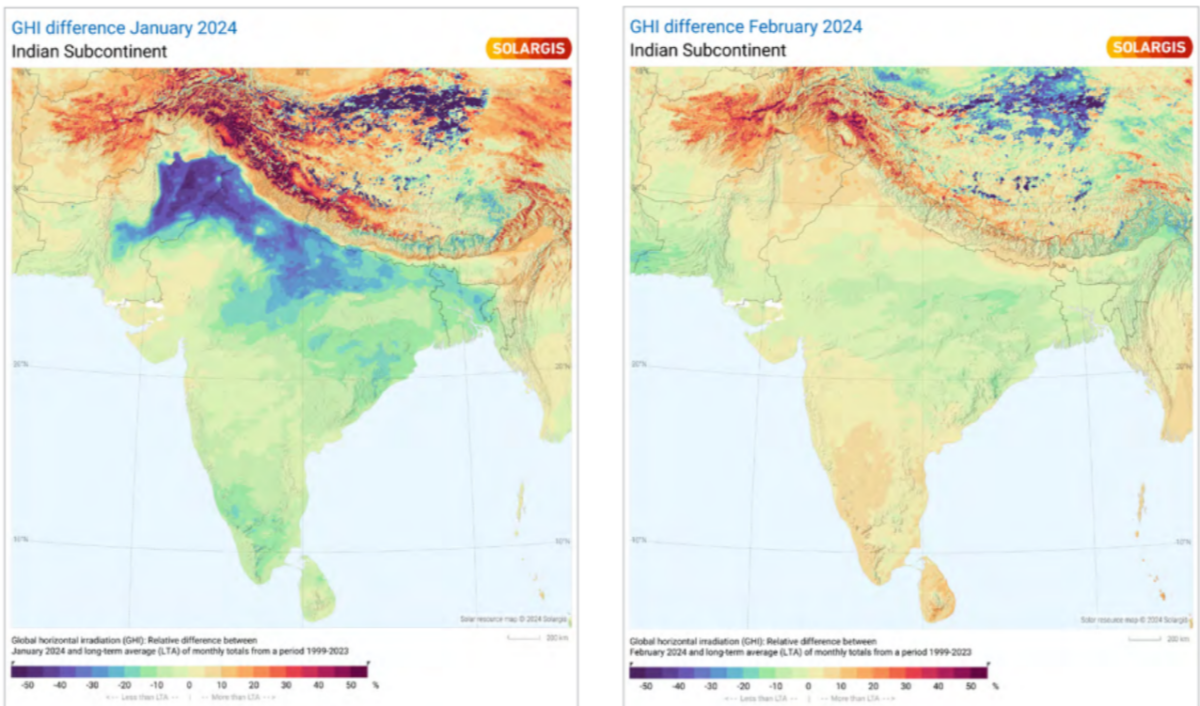Solargis, a solar data and software solutions company, warns that India’s solar power generation is being significantly impacted by poor air quality during winter months.
According to new data from the company, in January 2024 Northern India experienced the poorest air quality in decades, with some localities facing persistent fog or smog lasting up to 20 days.
The maps show that high aerosol levels are having a direct impact on the performance of solar projects in the region. Solargis’ monthly Global Horizontal Irradiance (GHI) map for January 2024 shows substantial drops in solar irradiance– between 30% and 50% – compared to long term averages. This continues a longer-term trend of Winter underperformance in Northern India, which has seen significant dips in irradiance occur in each of the last five Winters.
Avik Mitra, business account manager, Solargis, said, “January 2024 saw records broken for both the lowest average monthly temperature and lowest GHI. This had tangible impacts on the financial performance of solar projects across Punjab, Haryana, and Uttar Pradesh, which collectively host around 5 GW of installed capacity. But this has not been an isolated event.”
In addition to this recurring pattern of Winter underperformance in the North, operators in central India have faced a long-term trend of below-average irradiance, stretching back over the past 6 years. Solargis’ 2023 Indian solar performance maps show a dip of between 1% and 5% compared to the average across central India – attributed in part to the prolonged monsoon season.
Mitigating resource-related underperformance
To help the industry better understand and mitigate the impact of these resource challenges, Solargis is working with a number of leading solar PV firms in India and providing them irradiance data to pinpoint and address underperformance.
Chris Brosz, head of Engineering at candi solar, said, “We’ve grappled with identifying the root causes of underperformance for our projects in India and recognized the need for accurate yield information. Relying on robust and high-quality data has enabled us to optimize our project performance and build a scalable platform.”
Mitra said, “There is an increasing need for Indian operators to move beyond hourly Typical Meteorological Year (TMY) data and towards higher resolution sub-hourly Time Series for more reliable performance evaluation. This allows analysis of solar power production in extreme weather, like severe fog and smog, and enhances understanding of PV plant behaviour.”
Simultaneously, Indian solar developers are investing in higher quality data to understand long-term irradiance trends and the future performance of increasingly complex renewable energy assets. The Indian market has moved from 100% solar tenders to hybrid tenders incorporating both battery energy storage and wind energy, demanding a better understanding of how performance will be influenced by changing weather patterns.
“Often these hybrid tenders require matching generation profiles with load profiles, and there are penalties for not doing so. This has increased the need for developers to better grasp solar variability – both at intra-day and seasonal levels – and diversify their portfolios to manage financial risk,” added Mitra.
This content is protected by copyright and may not be reused. If you want to cooperate with us and would like to reuse some of our content, please contact: editors@pv-magazine.com.









1 comment
By submitting this form you agree to pv magazine using your data for the purposes of publishing your comment.
Your personal data will only be disclosed or otherwise transmitted to third parties for the purposes of spam filtering or if this is necessary for technical maintenance of the website. Any other transfer to third parties will not take place unless this is justified on the basis of applicable data protection regulations or if pv magazine is legally obliged to do so.
You may revoke this consent at any time with effect for the future, in which case your personal data will be deleted immediately. Otherwise, your data will be deleted if pv magazine has processed your request or the purpose of data storage is fulfilled.
Further information on data privacy can be found in our Data Protection Policy.